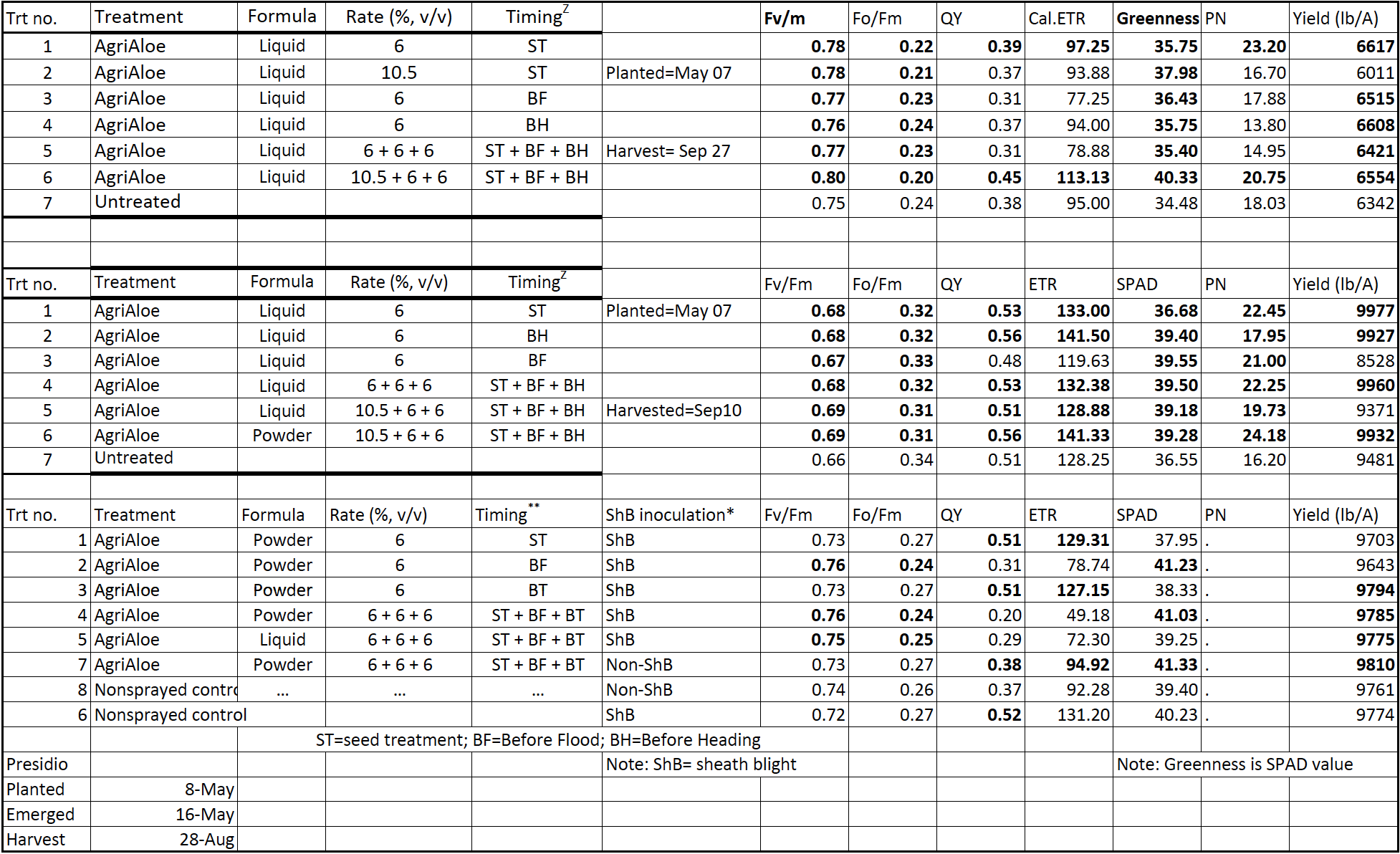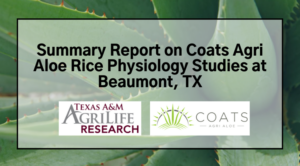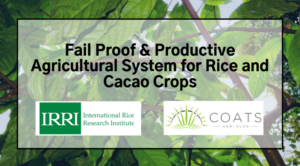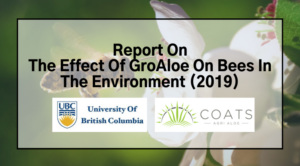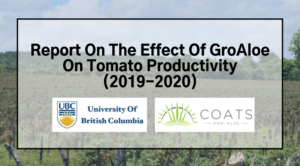TEXAS A&M AGRILIFE RESEARCH CENTER AT BEAUMONT 1509 Aggie Drive Beaumont, Texas 77713 Tel. 409.752.2741 ext. 2235 Fax. 409.752.5560 [email protected]
Summary Report on Coats AgriAloe Rice Physiology Studies at Beaumont, TX 2013-‘15
Prepared by Lee Tarpley and Abdul Razack Mohammed
In cooperation with Shane Zhou and “Mo” Way
During the three-year period of 2013 through 2015, field studies were conducted at the Texas A&M AgriLife Research Center at Beaumont, Texas to evaluate the potential use of AgriAloe to benefit U.S. rice production. The studies were multi-disciplinary by design based on some of the known effects of AgriAloe. In 2013, the study included entomology, plant pathology, and plant physiology. In later years, the study included plant pathology and plant physiology. The Plant Pathology summary report over the three years has been provided separately. Here, the Plant Physiology summary findings are presented.
The studies were conducted using replicated research plots. The actual treatments varied somewhat from year to year as our understanding of the potential benefits of the AgriAloe product improved. An example field lay-out was provided in the combined 2013 report.
The philosophy/approach of the Plant Physiology studies is to pay attention to two aspects of the physiology when monitoring rice crop response to AgriAloe. These Aspects are (1) yield, net photosynthesis, and leaf greenness, and (2) photochemistry. Between these, the photochemical measurements (Aspect 2) provide a better snapshot of crop stress, but, also, are a more transitory measure than Aspect 1 variables. The Aspect 1 variables tend to integrate the crop’s interaction with the environment over time. For example, yield is influenced by events affecting plant health earlier in development; similarly, net photosynthesis can be impacted by decreased leaf cell integrity, which is itself influenced by ‘stress’ events over development. Both Aspects 1 and 2 were considered important to measure in this study because of the anticipated benefits of AgriAloe to promote overall crop health throughout crop development. In addition, photosynthesis is quite a complicated process, and the photochemical measures help partition out effects on photosynthesis. A simple measure of yield could easily have missed beneficial effects of AgriAloe under some circumstances.
The summary results are presented across years, and so are analyzed as treated vs. untreated to eliminate year-to-year variation in the measured variables. For each mentioned measured variable, a p-value is provided in parentheses. This p-value roughly represents the likelihood that this result was obtained due to random variation within the normal distribution of the measured variable. The smaller the p-value, the less likely the result was due to chance rather than a treatment effect. The treatments are represented by the means of the replicates for a given year X treatment combination, and are thus assumed to be the best measure available of the sample mean to be used for the following analyses.
Aspects 1 (integrated variables): Across years (3 year) and treatments (18 treatments), rice plants treated with AgriAloe Yield more (13 out of 18 times; p < 0.05) than the untreated plants. Yield is often associated with increased greenness and net photosynthetic rate along with effectiveness of Photosystem-II. Rice plants treated with AgriAloe had more Greenness (15 out of 18 times; p < 0.01) than the untreated plants. The AgriAloe treatments did not obviously increase Net Photosynthesis over untreated (8 out of 12 times; p-value not determined) (Photosynthesis was not measured in 2015 because of weather-related issues). Overall, the Aspect 1 results support the notion that AgriAloe benefitted yield and associated integrated physiological measures.
Aspects 2 (photochemistry). The Fv/Fm is the most common of the leaf photochemistry measurements obtained. It and quantum yield (QY) are the most important of the photochemical parameters we measured; both concern effectiveness of Photosystem II, which is the part of the photosystem that is most strongly influenced by environmental stresses. The tendency toward higher Fv/Fm (15 out of 18 times; p < 0.01) and similar QY values (higher 10 out of 18 times; p-value not determined) with AgriAloe treatment is in line with similar or possible benefit on net photosynthesis (PN). The Fo/Fm measures thylakoid membrane stability. The thylakoids are the inner membrane structure inside chloroplasts; their maintained integrity is critical for maintaining good spatial separation of some of the chemical reactions at the heart of the activity of photosynthesis, so their stability is important for good photosynthetic activity. The decrease (15 out of 18 times; p < 0.01) in Fo/Fm is supportive of relatively good thylakoid membrane stability (i.e., a higher value is indicative of more stress response), thus potential for good photosynthetic activity, in response to AgriAloe treatment. Finally, ETR, or electron transport rate, measures the activity of a particular component of photosynthesis, so works with the other variables to provide a clearer picture of possible limitations in photosynthesis. ETR tends to have a curvilinear positive relationship with photosynthetic activity in plants such as rice. The levels observed in this study are high enough to indicate good plant (leaf) health. Putting everything together, the Aspect 2 pattern of response is consistent in indicating benefit from AgriAloe on net leaf photosynthesis under the conditions of our studies.
The results across Aspect 1 and Aspect 2 variables are consistent with AgriAloe providing benefit to the rice crop produced with typical U.S.-style management, and under diverse environmental conditions (the different years). The results indicate that AgriAloe often provides a physiological benefit to the crop through plant development, which in turn benefits yield.
Powder vs liquid: In comparison of the 10.5 + 6 + 6 treatments using the liquid or the powder formulation, all responses in physiological factors due to the powder treatment equaled or exceeded the responses of the liquid formulation, providing preliminary evidence that the powder formulation has suitable efficacy. If true, this should save on shipping, and possibly storage, costs.
6+6+6 vs 10.5+6+6 ST + BF + BH: In comparison of these two “Cadillac treatments” (luxury treatments) using the liquid formulations applied sequentially at several developmental stages, all responses in physiological factors due to the 6+6+6 treatment equaled or exceeded the responses of the 10.5+6+6 treatment, providing preliminary evidence that the reduced rate was at least equally efficacious. If it turns out that the repeated application is the way to go, then the lower rate applied to seed appears adequate.
The summary physiology results for the three years in chronological order are appended.
Most methodology has previously been provided. Following are the specific application methods for the AgriAloe.
Seed treatment method varied between 2013 and 2014/15:
2013: Seed treatment preparation: for each seed treatment rate, 3 gal of water was mixed with the proper amount of AgriAloe in a large bucket, 2 lb of seed for each rate was placed in a cloth bag which was submerged in the proper solution in the above buckets, the submerged cloth bags were massaged by hand under water for 3 minutes, bags were removed from the buckets and allowed to drain, rice in bags was removed and placed on butcher paper and air-dried for about 3 hours
2014/2015: Seed treatment preparation: Powder was made to 6% (v/v) or 10.5% (v/v) liquid. Rice was soaked for 1 hour in just enough of the preparation to cover the seed. The seed was then dried.
Foliar Sprays were similar across years: Treatments applied using a hand-held, CO2 pressurized, 3 nozzle (800067 tips with 50 mesh screens, 29 gpa final spray volume) spray rig. Spray treatments were made at sunset.
